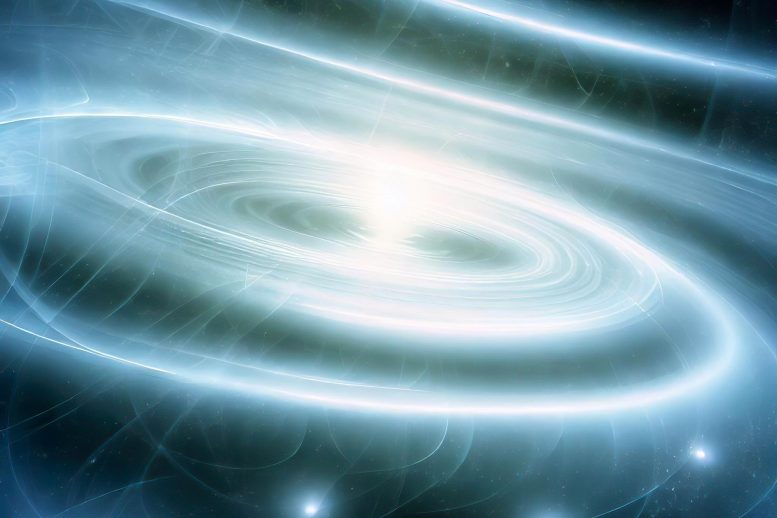L’innovazione nei rilevatori di onde gravitazionali potrebbe aiutare a rivelare segreti cosmici

I grandi progressi nella tecnologia dei film sottili hanno il potenziale per migliorare la sensibilità dei rilevatori di onde gravitazionali, facilitando una comprensione più profonda dell’universo. La nuova tecnologia è stata sviluppata presso l’Institute for Thin Films, Sensors and Imaging presso UWS e prevede la produzione di film sottili con basso rumore termico e il miglioramento della loro capacità di rilevamento.
I ricercatori hanno sviluppato una tecnologia a film sottile che migliora la sensibilità di un rilevatore di onde gravitazionali. Questa svolta promette di approfondire la nostra comprensione dell’universo, ampliare il rilevamento di eventi cosmici e potrebbe beneficiare di dispositivi ad alta precisione come orologi atomici e computer quantistici.
Nuove frontiere nello studio dell’universo – f[{” attribute=””>gravitational waves – have been opened up following a breakthrough by University of the West of Scotland (UWS) researchers.
The groundbreaking development in thin film technology promises to enhance the sensitivity of current and future gravitational wave detectors. Developed by academics at UWS’s Institute of Thin Films, Sensors and Imaging (ITFSI), the innovation could enhance the understanding of the nature of the universe.
Gravitational waves, first predicted by Albert Einstein’s theory of general relativity, are ripples in the fabric of spacetime caused by the most energetic events in the cosmos, such as black hole mergers and neutron star collisions. Detecting and studying these waves provides invaluable insights into the fundamental nature of the universe.
Dr. Carlos Garcia Nuñez, Senior Lecturer at School of Computing, Engineering and Physical Sciences (CEPS), said: “At the Institute of Thin Films, Sensors and Imaging, we are working hard to push the limits of thin film materials, exploring new techniques to deposit them, controlling their properties in order to match the requirements of current and future sensing technology for the detection of gravitational waves.”
“The development of high reflecting mirrors with low thermal noise opens a wide range of applications, which covers from the detection of gravitational waves from cosmological events to the development of quantum computers.”
The technique used in this work — originally developed and patented by Professor Des Gibson, Director of UWS’s Institute of Thin Films, Sensors and Imaging – could enable the production of thin films that achieve low levels of “thermal noise”. The reduction of this kind of noise in mirror coatings is essential to increase the sensitivity of current gravitational wave detectors – allowing the detection of a wider range of cosmological events — and could be deployed to enhance other high-precision devices, such as atomic clocks or quantum computers.
Professor Gibson said: “We are thrilled to unveil this cutting-edge thin film technology for gravitational wave detection. This breakthrough represents a significant step forward in our ability to explore the universe and unlock its secrets through the study of gravitational waves. We believe this advancement will accelerate scientific progress in this field and open up new avenues for discovery.”
“UWS’s thin film technology has already undergone extensive testing and validation in collaboration with renowned scientists and research institutions. The results have been met with great enthusiasm, fuelling anticipation for its future impact on the field of gravitational wave astronomy. The coating deposition technology is being commercialized by UWS spinout company, Albasense Ltd.”
The development of coatings with low thermal noise will not only make future generations of gravitational wave detectors more precise and sensitive to cosmic events, but will also provide new solutions to atomic clocks and quantum mechanics, both highly relevant for the United Nations’ Sustainable Development Goals 7, 9 and 11.
Reference: “Amorphous dielectric optical coatings deposited by plasma ion-assisted electron beam evaporation for gravitational wave detectors” by Carlos Garcia Nuñez, Gavin Wallace, Lewis Fleming, Kieran Craig, Shigeng Song, Sam Ahmadzadeh, Caspar Clark, Simon Tait, Iain Martin, Stuart Reid, Sheila Rowan and Des Gibson, 23 February 2023, Applied Optics.
DOI: 10.1364/AO.477186

“Esploratore. Scrittore appassionato. Appassionato di Twitter. Organizzatore. Amico degli animali ovunque.”
